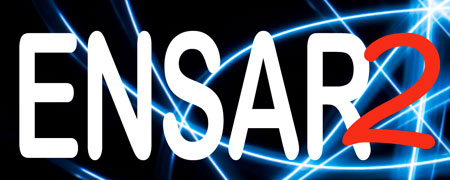Difference between revisions of "Main Page"
MedinetAdmin (talk | contribs) |
|||
| (6 intermediate revisions by 2 users not shown) | |||
| Line 1: | Line 1: | ||
| − | |||
| − | + | <gallery mode="packed-hover"> | |
| + | Image:MediNet.jpg | ||
| + | Image:at.jpg | ||
| + | Image:Ensar2_logo.jpg | ||
| + | </gallery> | ||
| − | + | '''ENSAR2: a European project for Nuclear Physics''' | |
| − | + | ||
| − | * | + | ENSAR2 is the integrating activity for European nuclear scientists who are performing research in three of the major subfields defined by '''NuPECC''': Nuclear Structure and Dynamics, Nuclear Astrophysics and Nuclear Physics Tools and Applications. It proposes an optimised ensemble of Networking (NAs), Joint Research (JRAs) and Transnational Access Activities (TAs), which will ensure qualitative and quantitative improvement of the access provided by the current ten infrastructures (GANIL-SPIRAL2 (F), joint LNL-LNS (I), CERN-ISOLDE (CH), JYFL (FI), ALTO (F), GSI (D), KVI-CART (NL), NLC (PL), IFIN-HH/ELI-NP (RO) and the theoretical physics facility: ECT* (I)), which are at the core of this project. Our community of nuclear scientists makes great effort to pursue excellent scientific programmes at these infrastructures and to apply state-of-the-art developments to other fields and to benefit humanity (e.g., archaeology, medical imaging). These activities ensure a high-level socio-economic impact. To enhance the access to these facilities, the community has defined a number of JRAs dealing with novel and innovative technologies to improve the operation of the facilities. The NAs of ENSAR2 have been set-up with specific actions to strengthen the communities coherence around certain research topics and to ensure a broad dissemination of results and stimulate multidisciplinary, application-oriented research and innovation at the Research Infrastructures. |
| − | + | ||
| − | + | '''MediNet: Medical Network''' | |
| − | + | ||
| + | The MediNet networking activity within ENSAR2 is dedicated to strengthen the application of nuclear-physics related knowledge, technology and expertise to advance tumour treatment and thus to address one of the questions of highest societal relevance. The optimization of radiation therapy in general and particle therapy in particular requires research on a variety of topics such as beam delivery optimization, in-vivo monitoring of the delivered dose, dosimetry, radiobiology and radiation quality. Expertise in nuclear techniques for the detection and characterization of charged particles and photons is crucial to each of these objectives. Large efforts are therefore devoted to the development of innovative detector technologies and modelling in several European research groups, focusing on both clinical and pre-clinical applications of particle therapy. MediNet is providing a platform to bring together these experts for exchange of existing and development of new ideas, as well providing a training opportunity for young researchers. | ||
| + | |||
| + | [[File:ECflagyellowlow.jpg|center|208x67px|ECflagyellowlow.jpg|link=]] | ||
| + | <p style="text-align: center">ENSAR2 has received funding from the European Union’s Horizon 2020 research and innovation programme under grant agreement No 654002.</p><p style="text-align: center"></p> | ||
Latest revision as of 12:36, 14 December 2021
ENSAR2: a European project for Nuclear Physics
ENSAR2 is the integrating activity for European nuclear scientists who are performing research in three of the major subfields defined by NuPECC: Nuclear Structure and Dynamics, Nuclear Astrophysics and Nuclear Physics Tools and Applications. It proposes an optimised ensemble of Networking (NAs), Joint Research (JRAs) and Transnational Access Activities (TAs), which will ensure qualitative and quantitative improvement of the access provided by the current ten infrastructures (GANIL-SPIRAL2 (F), joint LNL-LNS (I), CERN-ISOLDE (CH), JYFL (FI), ALTO (F), GSI (D), KVI-CART (NL), NLC (PL), IFIN-HH/ELI-NP (RO) and the theoretical physics facility: ECT* (I)), which are at the core of this project. Our community of nuclear scientists makes great effort to pursue excellent scientific programmes at these infrastructures and to apply state-of-the-art developments to other fields and to benefit humanity (e.g., archaeology, medical imaging). These activities ensure a high-level socio-economic impact. To enhance the access to these facilities, the community has defined a number of JRAs dealing with novel and innovative technologies to improve the operation of the facilities. The NAs of ENSAR2 have been set-up with specific actions to strengthen the communities coherence around certain research topics and to ensure a broad dissemination of results and stimulate multidisciplinary, application-oriented research and innovation at the Research Infrastructures.
MediNet: Medical Network
The MediNet networking activity within ENSAR2 is dedicated to strengthen the application of nuclear-physics related knowledge, technology and expertise to advance tumour treatment and thus to address one of the questions of highest societal relevance. The optimization of radiation therapy in general and particle therapy in particular requires research on a variety of topics such as beam delivery optimization, in-vivo monitoring of the delivered dose, dosimetry, radiobiology and radiation quality. Expertise in nuclear techniques for the detection and characterization of charged particles and photons is crucial to each of these objectives. Large efforts are therefore devoted to the development of innovative detector technologies and modelling in several European research groups, focusing on both clinical and pre-clinical applications of particle therapy. MediNet is providing a platform to bring together these experts for exchange of existing and development of new ideas, as well providing a training opportunity for young researchers.

ENSAR2 has received funding from the European Union’s Horizon 2020 research and innovation programme under grant agreement No 654002.


